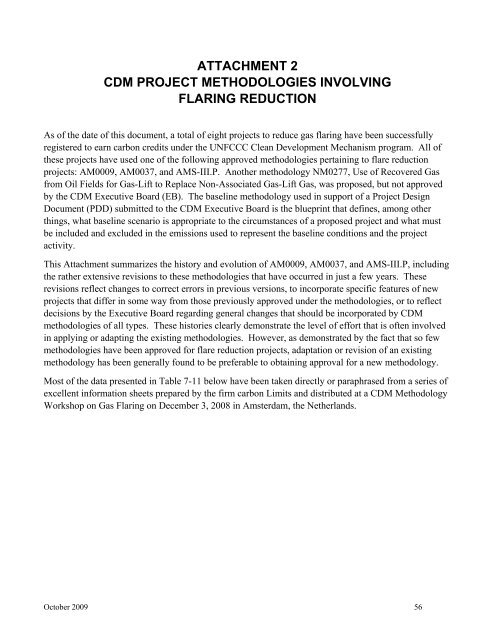Part III: Flare Reduction Project Family - IPIECA
Part III: Flare Reduction Project Family - IPIECA
Part III: Flare Reduction Project Family - IPIECA
You also want an ePaper? Increase the reach of your titles
YUMPU automatically turns print PDFs into web optimized ePapers that Google loves.
ATTACHMENT 2<br />
CDM PROJECT METHODOLOGIES INVOLVING<br />
FLARING REDUCTION<br />
As of the date of this document, a total of eight projects to reduce gas flaring have been successfully<br />
registered to earn carbon credits under the UNFCCC Clean Development Mechanism program. All of<br />
these projects have used one of the following approved methodologies pertaining to flare reduction<br />
projects: AM0009, AM0037, and AMS-<strong>III</strong>.P. Another methodology NM0277, Use of Recovered Gas<br />
from Oil Fields for Gas-Lift to Replace Non-Associated Gas-Lift Gas, was proposed, but not approved<br />
by the CDM Executive Board (EB). The baseline methodology used in support of a <strong>Project</strong> Design<br />
Document (PDD) submitted to the CDM Executive Board is the blueprint that defines, among other<br />
things, what baseline scenario is appropriate to the circumstances of a proposed project and what must<br />
be included and excluded in the emissions used to represent the baseline conditions and the project<br />
activity.<br />
This Attachment summarizes the history and evolution of AM0009, AM0037, and AMS-<strong>III</strong>.P, including<br />
the rather extensive revisions to these methodologies that have occurred in just a few years. These<br />
revisions reflect changes to correct errors in previous versions, to incorporate specific features of new<br />
projects that differ in some way from those previously approved under the methodologies, or to reflect<br />
decisions by the Executive Board regarding general changes that should be incorporated by CDM<br />
methodologies of all types. These histories clearly demonstrate the level of effort that is often involved<br />
in applying or adapting the existing methodologies. However, as demonstrated by the fact that so few<br />
methodologies have been approved for flare reduction projects, adaptation or revision of an existing<br />
methodology has been generally found to be preferable to obtaining approval for a new methodology.<br />
Most of the data presented in Table 7-11 below have been taken directly or paraphrased from a series of<br />
excellent information sheets prepared by the firm carbon Limits and distributed at a CDM Methodology<br />
Workshop on Gas Flaring on December 3, 2008 in Amsterdam, the Netherlands.<br />
October 2009 56

















